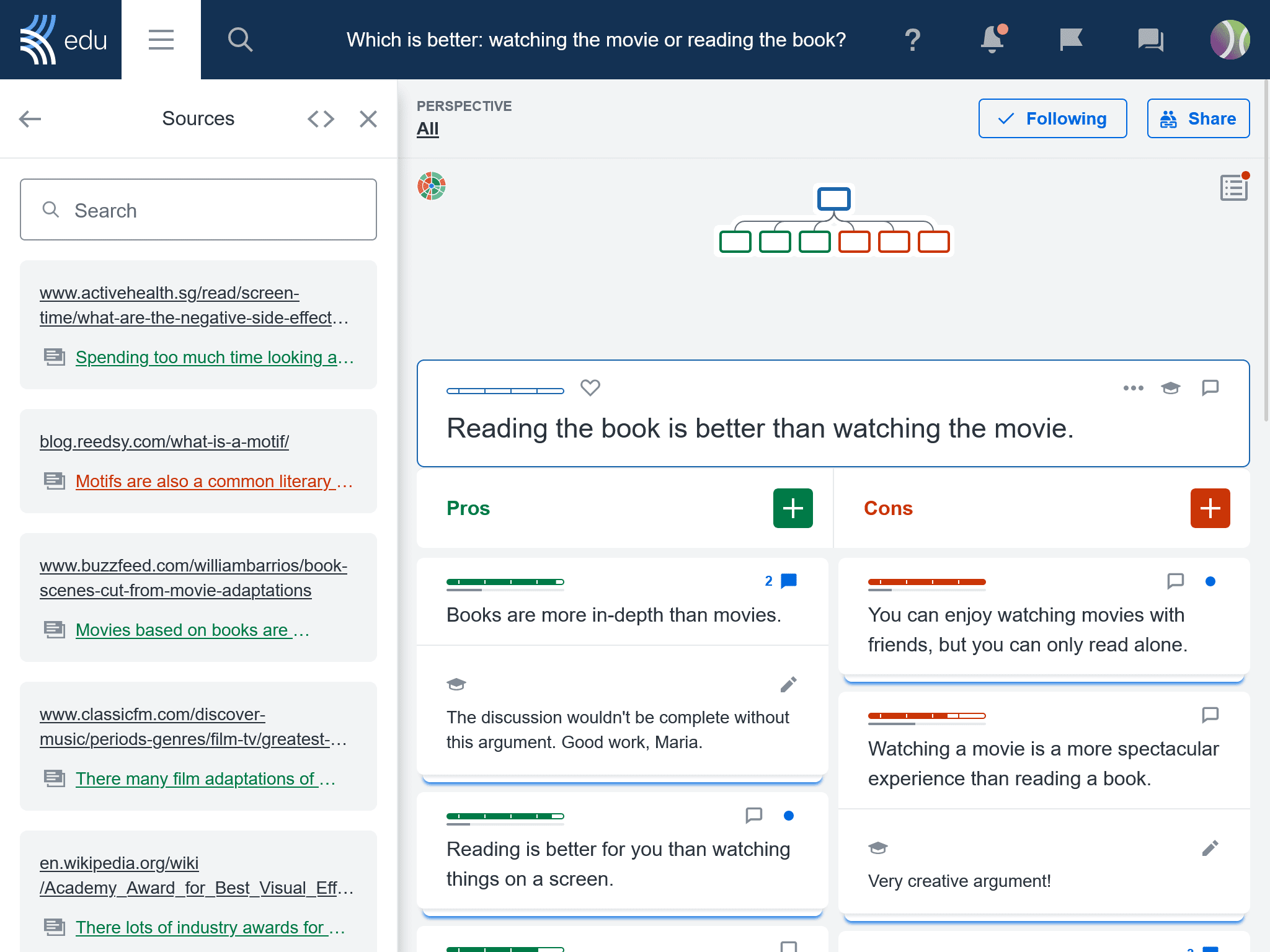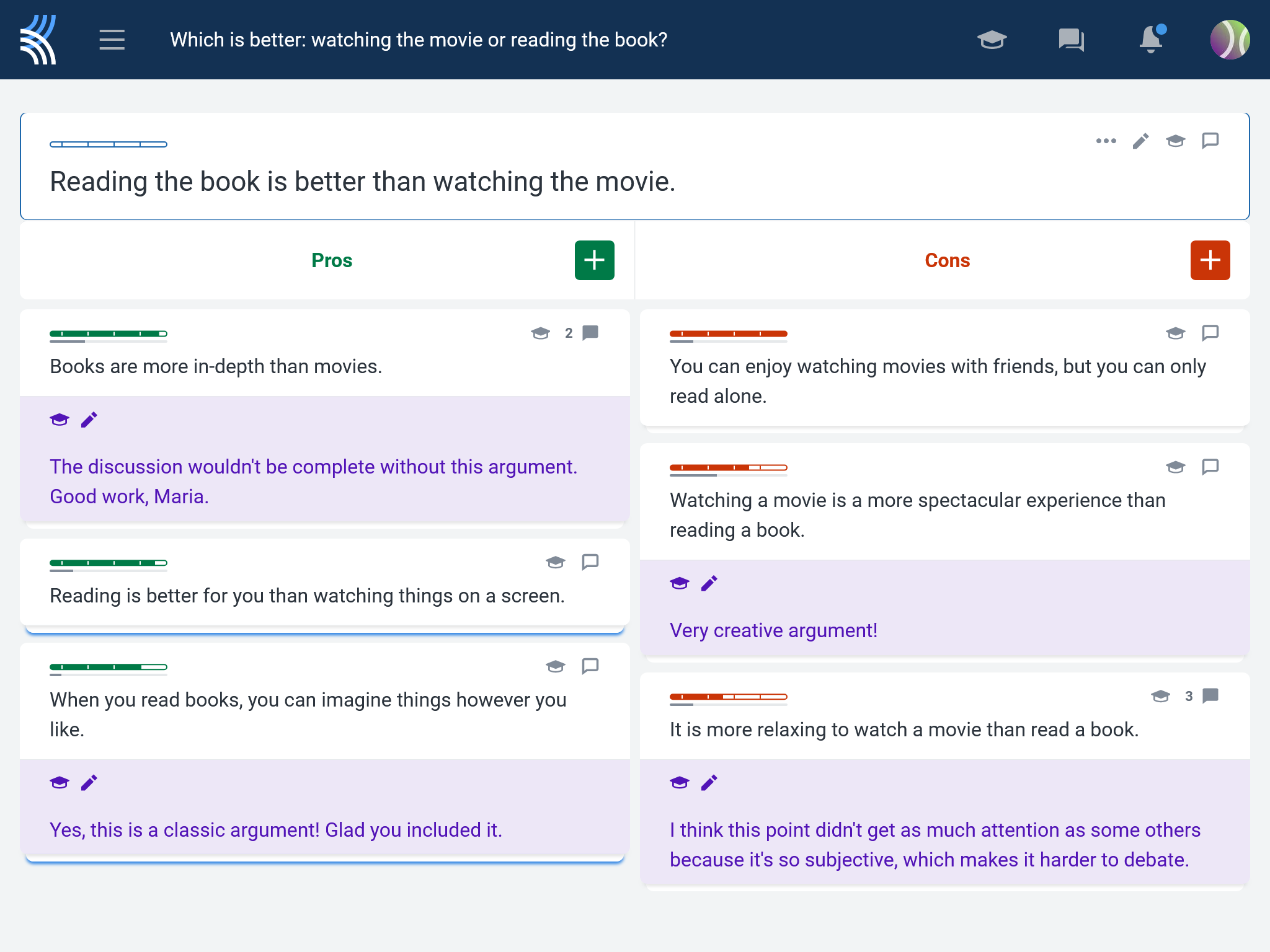Integrating technology into ESL classes is a dynamic and effective approach for engaging students. And using Kialo is a great way to do so!
Whether it’s by letting students work at their own pace in mixed-level classes, ensuring they’re producing language in context, or targeting specific linguistic needs, Kialo discussion brings many benefits to the language classroom. Let’s look at some activities using Kialo discussions to enhance your ESL classes!
1. Use Kialo discussions to practice popular ESL topics
Food, travel, work…certain topics in ESL coursebooks crop up year after year. But they do so with good reason! Such topics strike a chord with students, meaning everyone will have something to say.
Kialo discussions can help keep these topics fresh across all levels. By adding carefully chosen starter claims to prompt your students, you can ask students to respond with more complex ideas, bringing in meaningful cross-topic references to enhance the language challenge!
In a discussion on dealing with stress, for instance, students might engage with vocabulary on activities they enjoy in their free time and personal finances, while weighing screen time woes against smartphone needs.
You can also link discussions to your students’ interests while still meeting your language curriculum needs. A discussion on TikTok, for instance, will require students to weigh up the impact of social media on society and individuals, while also encouraging the use of technology-specific language in areas such as misinformation and online connections.
2. Use Kialo discussions to build confidence in reading
As a reading task to practice fluency, educators can first complete a discussion and then invite students to explore and engage with it. The short, focused form of claims lets students deal with one piece of text, or argument, at a time. And since claims can stand alone while also contributing to the central topic, students get a meaningful reading experience.

3. Use Kialo discussions to build confidence in writing
Students can practice their target language at sentence, or claim, level before incorporating it into longer-style texts. They can experiment with more complex structures and topic-specific lexis in a meaningful and focused way.
In a discussion, students aren’t simply writing empty or context-free examples of the language in use, but rather contributing towards a wider topic in collaboration with their peers.
4. Use Kialo discussions to build confidence in speaking
Language learning requires risk-taking. However, being prepared to put yourself out there in front of peers and more fluent speakers alike is often easier said than done! Kialo discussions are also a great way to help students build confidence in their speaking skills. Discussions let them figure out both what to say and how to say it in preparation for speaking activities.
And for those who struggle deeply with oral communication, the format of Kialo discussions means they can still participate in collaborative group interactions.
5. Use Kialo discussions to deeply engage with authentic materials
Authentic materials can greatly motivate learners by providing a tangible sense of how the language is used in real-world contexts. But the same complexity that lends them their richness can also prove frustrating for students if they don’t have the necessary knowledge to truly engage with them!
In addition, teachers often need significant time to prepare supporting tasks for the material, whether that’s in terms of noting interesting idiomatic language and natural collocations, recognizing nuance or tongue-in-cheek references, or identifying subtle markers of attitude and opinion.
To get started, simply choose a challenging newspaper article, novel extract, or podcast, and write a thesis that requires students to take a stance on the topic. Prompt students to add a source to each claim that highlights the exact sentence, phrase, or paragraph that supports their claim. In doing so, students are prompted to seek and demonstrate deeper understanding of the material while also expressing their own opinions within the discussion.

To close, encourage each student to identify three interesting lexical chunks they want to remember from the input material and record the newfound knowledge in the background info for easy access.
6. Using authentic materials in Kialo discussions for task-based learning
Integrated skills reflect real-world communication, where skills and language features are rarely used in isolation. Added to that, using skills together makes for dynamic and interactive learning experiences.
For example, if you’re utilizing task-based learning during a lesson, you might have students plan a trip together to serve a genuine communicative need. In this task, students might read about different destinations in travel guides, get travel tips from travel vloggers, and discuss and design an itinerary.
On Kialo, have students use a multi-thesis discussion to weigh up the pros and cons of different destinations and encourage them to communicate in the discussion as they would in a group chat to hit the right tone.
7. Discuss current events using authentic materials
Current events can be very complex, and not only due to the language used to report them, but because of the issues they involve. Students may struggle to articulate their thoughts and opinions appropriately on potentially sensitive topics.
Educators can use Kialo discussions to scaffold such discussions, giving students time to consider what they want to say and reference language resources.
Provide a suitable news article to engage with alongside background information on the topic, such as a radio report or interview with an expert. Create a thesis and starter claims to encourage students to explore the topic from different perspectives, and task small groups of students with using the discussion to organize all their gathered information. Have them come together after the Kialo discussion to speak about what they learned on the topic.
8. Use Kialo as a learning review and error correction tool
Wrapping up a unit with a Kialo discussion is a great way to bring closure to the topic! Students can return to it time and time again to review the language they used during the learning unit. You can also use a Kialo discussion for continuous assessment to encourage students to really show off their new language knowledge.

Our Grading and Feedback tool is a highly efficient way to grade claims as it includes a customizable grading scale to help you break down and assign points as it suits your rubric. You might use grading to encourage students to use topic-specific vocabulary, particular language structures, or to address the specific nature of the thesis — good practice in tailoring writing tasks to the exact requirements of an exam question.
If you want to encourage self-correction, try using your preferred correction code in the feedback section. Ask your students to tag you in the comment section so you can review their edits.
9. Use Kialo discussions to focus on emergent language to help with error correction

Error correction doesn’t always have to involve “errors”! Helping students upgrade their language is a great way to bridge the gap between what they want to say and what they actually say.
Perhaps you spot where a more natural collocation would work better, or a more direct way to get the point across. Improving their fluency helps students use the language more naturally — and because you’re building on their own input, the new language will be more meaningful.
To do this on Kialo, adjust the visibility settings so users see feedback on all claims. This way, suggestions you make on individual claims will be prominently displayed for the whole class to see and benefit from. Make this a positive experience, encouraging students to discuss and make note of the new input while emphasizing that you aren’t highlighting errors, but rather opportunities for improvement.
10. Use Kialo discussions to practice tone
Discussions not only foster critical thinking and communication skills, but educators can also use them to help students focus on specific language features. In fact, Kialo can be highly effective in targeted language development as all claims in the discussion exist in a clear context that helps with a genuine communicative aim.
Here are some ideas to try out in your next discussion for practicing tone.
Write for different audiences
Have your students write their claims in different registers by first establishing an audience for the discussion. You might ask students to target their tone towards a skeptical friend, a college interviewer, or a prospective business investor.
Write in reported speech
Help students establish credibility and practice reported speech by having them quote experts or journalists to support their claims.
Write in active voice
After a discussion, task pairs with reviewing the claims for which active sentences can be changed to passive and vice-versa. Have them discuss what impact their changes will have when reading the discussion out loud.
11. Using Kialo discussions to practice conditional tenses
Conditional chain practice
Conditional chains are a classic activity to focus students on conditional structures. Have students respond to a thesis by building conditional chains of pros and cons, writing the full form for each claim.
You might try out a classic desert island survival scenario to practice second conditional, or invite discussion on historical topics to include third and mixed conditional structures.
Add context to conditional chains
As conditional chains involve unnatural interactions, they need to be balanced out with more natural approaches to communicative competence.
Ask students to return to the discussion once they have added their conditional structures to fill it out with a range of sentence types for contextual language use. That way, their conditional structures will be more meaningful as they will exist within a genuine discussion.
12. Use Kialo discussions to practice frequency and intensity
Practice using high-frequency words in claims
Prompt students to use descriptive and intensifying language in their claims to practice adding impact and making their arguments more persuasive.
You might provide some examples for inspiration, such as extremely unfortunate, highly unlikely, significantly improved, incredibly effective, and utterly irresponsible. Remind students that this language is most effective when used sparingly, so choose where to add it with care!
Taboo: ban simple high-frequency words
Try temporarily banning those high-frequency words your students tend to have an overreliance on. Though there’s nothing wrong with their using good, bad, people, nice, say, or very, push them to add greater variety for interest.
Scaffold this requirement by providing guidance and examples. You might give students a list of detailed verbs such as claim, assert, refute, and advocate for, as alternatives to say when referencing research or experts in their claims, for instance.
13. Use Kialo discussions to practice transitions
The format of a Kialo discussion makes the relationship between claims clear. But students can also explicitly state that relationship to practice using transitions meaningfully.
You might ask students to use concessive clauses to link cons to the claim above to acknowledge counter arguments or limitations. Or, they might use language of comparison, cause and effect, or addition in their pros, such as similarly, therefore, and moreover, to further develop the claim above.
These activities only scratch the surface of how Kialo can be used in the language classroom. We’d love to hear about any activities you try or would like to suggest! Please do get in touch on any of our social media channels or directly at feedback@kialo-edu.com!

